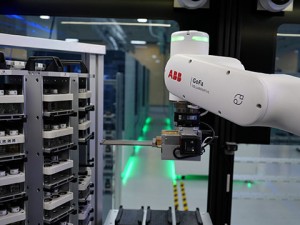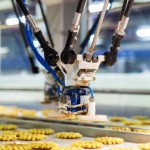ABB Robotics partners with XtalPi in China
 ABB Robotics and XtalPi have entered a strategic partnership to produce a range of automated laboratory work-stations in China. The new, automated laboratories will boost the productivity of R&D processes in biopharmaceuticals, chemical engineering and chemistry, and new energy materials.
ABB Robotics and XtalPi have entered a strategic partnership to produce a range of automated laboratory work-stations in China. The new, automated laboratories will boost the productivity of R&D processes in biopharmaceuticals, chemical engineering and chemistry, and new energy materials.
“Our collaboration with XtalPi marks another milestone for ABB’s collaborative robots in the life sciences sector,” said Jose-Manuel Collados, manager of the service robotics product line at ABB Robotics. “ABB Robotics and XtalPi will radically advance lab research and development through automation that works side-by-side with people.
“By enabling pharma and biotech companies to develop new drugs faster and with less cost, ABB is helping to further research into disease prevention, creating healthier societies. Our new Open Innovation Lab for Life Science and Healthcare in Zhangjiang, Shanghai complements our work at our Life Sciences and Healthcare Lab at the Texas Medical Center Campus in Houston.”
XtalPi is dedicated to driving intelligent and digital transformation in the life science and new materials in the chemicals industry. In 2022, the AI tech company bought over 100 GoFa cobots to create automated laboratory workstations at its testing facility in Shanghai, China.
This year, XtalPi officially launched the automation-centric brand XtalPi Intelligent Automation with the purpose of aiding researchers through automation equip-ment. Together with ABB Robotics, XtalPi Intelligent Automation is using GoFa cobots to automate the synthesis and crystallisation processes involved in developing new drugs and materials for its target industries.
The automated laboratory workstations can be customized to meet specific requirements, using different modules to complete various experiment steps. ABB’s GoFa cobots take on repetitive, manual tasks, while also working non-stop, accelerating the pace of experimentation. The large volumes of high-quality data generated will help to boost the efficiency of the Design-Make-Test-Analyse research cycle and provide a solid foundation for driving AI for science.
The GoFa cobots are used by XtalPi Intelligent Automation to develop preparation workstations, diluting and filtration workstations, reaction workstations, UPLC testing workstations, glovebox workstations, sample ware-houses, and Automated Guided Vehicles (AGV) to make lab research and development faster and more efficient.
Each automated workstation can perform hundreds of different experiments, with ABB’s GoFa cobots operating in a range of challenging environments, including glove boxes – with no moisture or oxygen– while performing intricate tasks such as opening lids and the placement of lab equipment, liquid handling, sample addition, filtration, dilution, magnetic stirring, rapid sampling and UPLC testing, with minimal supervision required. AMR’s equipped with GoFa cobots transfer samples automatically between workstations, increasing efficiency while further reducing costs.
Equipped with a GoFa cobot and four rotating columns, automated sample warehouses provide compact and efficient storage and retrieval for laboratory reagents, making the process more efficient and entirely traceable.
Chenxi Zhang, director of automation product management at XtalPi, said: “Through partnering with ABB, we can increase efficiency in laboratories by implementing a human-robot integration model. We hope to combine XtalPi’s intelligent software system and industry experience with ABB’s expertise in robotics to bring more innovative solutions to the pharmaceutical industry, which will in turn expand the usage of automation and robots in the R&D process and help automate laboratories.”
Visit the ABB Robotics website for more information
See all stories for ABB Robotics
















